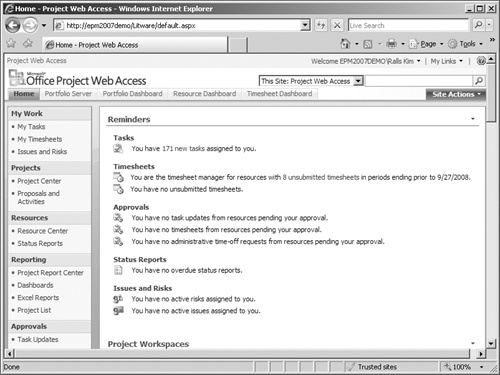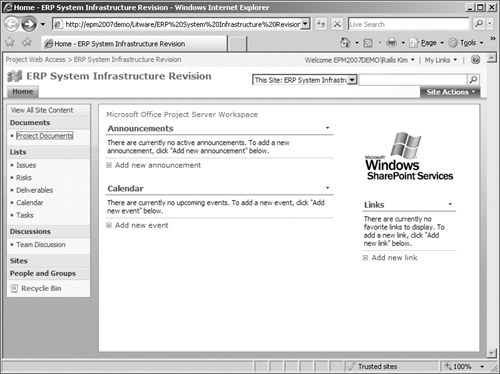Some companies perform most or all of their work in projects. For example, consulting firms take on different clients with different needs; each need would be a project. Book publishers set up projects for each book they publish. The sheer number of projects these companies perform drives the need to manage the company’s portfolio of projects with every bit as much effort and detail as is needed to manage individual projects.
Other companies may not perform all or even most of their work in projects, but the projects that they do perform are large, complex, and sometimes even far-flung geographically. For example, your company may decide to open international plants. Large, complex projects are usually a challenge to manage from a communications perspective, particularly if you have resources working in different parts of the world.
In situations like these, Project Server might work well in helping your organization manage its projects along with its limited resources. Using Project Server, your organization stores all projects and all resources in one central database on your company’s local area network (LAN) or intranet so that project managers can match limited resources to projects. Project managers in the organization install and use Project Professional to create projects in the same way they use Project without connecting it to Project Server. Project managers also can use tools in Project Professional to search the Project Server Enterprise Resource Pool for resources and assign them to tasks in projects. Project managers publish their projects in the Project Server database and then receive updated project information in Project Professional as team members provide it in the Project Server database.
Team members use Microsoft Office Project Web Access (see 9-1), a browser-based product, to view and update project data that is stored in the Project Server database. Team members can, for example, receive, refuse, and delegate work assignments and update assignments with progress and completion information using a familiar timesheet format. Team members also can send status reports to the project manager and attach supporting documentation, such as budget estimates or feasibility studies, to a project.
Figure 9-1. A typical Project Web Access home page, where the navigation pane appears down the left side of the screen.
This browser-based interface, connected to a networked database of projects, eases communication between team members and project managers. In addition, because you store all projects and all resources in the Project Server database, management can use Project Web Access to assess how things are going across all of the company’s projects.
Microsoft Windows SharePoint Services, which works with Project Server, provides a Web-based way to enhance collaboration between members of a project team. Using SharePoint, users can easily create workspaces for projects, where they can store project-related documents, record issues or project risks that arise during a project, and view or create a list of deliverables associated with a project—these deliverables can also be linked to Project Professional to manage dependencies across projects. Users can view or update a calendar of meetings, deadlines, and other important project-related events, and establish a task list to keep track of work a team needs to complete. In a project’s SharePoint workspace, users also can hold newsgroup-style discussions. In 9-2, you see a sample workspace Home page.
Figure 9-2. A typical SharePoint workspace for a project, in which the navigation pane appears down the left side of the screen.
So how do you decide if you really need Project Server? Project Server can help you if:
Your organization manages large-scale projects or many different projects using the same resources.
Your organization no longer wants project managers to spend time tracking down work information from resources and recording it into a project. Instead, your organization wants resources to record their time directly in project schedules.
Your team members need access to project data outside your company’s home office.
Your organization is willing to invest in the configuration and maintenance of both the hardware and software required for project administration and the systems infrastructure.
Your organization is willing to invest in and adopt a common approach to resource configuration and establish standards and conventions necessary to generate the types of reports or views desired.
Security and administration are serious issues if you decide to use Project Server and place all of the information about your organization’s work into a centralized database. Although your LAN or intranet has been secure from the outside world from the moment you implemented it, Project Server introduces additional security needs. You need to secure the various projects within the Project Server database, since everybody working on projects stored in the database doesn’t need to see every project. In fact, team members on the same project may need access to different information. So using Project Server also requires either a new employee or somebody in your organization to assume the additional responsibilities of the Project Server administrator, who, along with other administrative jobs such as establishing who can access the Project Server database, sets up security within the database to identify what each person accessing the database can see.


